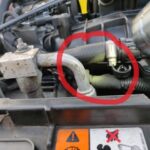The Direct Shift Gearbox (DSG), also known as a dual-clutch transmission, has become increasingly common in modern vehicles, offering a blend of automatic convenience and manual efficiency. For drivers, operating a car equipped with a DSG feels remarkably similar to driving a traditional automatic, despite the significantly different mechanics under the hood. Let’s delve into the workings, benefits, and potential issues of the DSG transmission.
Just like a conventional automatic car, a DSG-equipped vehicle simplifies driving with its two-pedal setup – an accelerator and a brake. You’ll also find familiar settings like Park, Reverse, Neutral, and Drive. Engaging these drive modes typically requires depressing the brake pedal, a standard safety feature in automatic transmissions.
When it comes to low-speed maneuvering, DSGs mimic automatic transmissions by exhibiting ‘creep.’ In Drive or Reverse, releasing the brake pedal will cause the car to move forward or backward slowly. This feature is particularly helpful when parking or navigating tight spaces, providing a smooth and controlled experience.
Many contemporary DSG-equipped cars also include a manual mode, granting drivers the ability to override the automatic gear selection. This manual control can be beneficial in various driving situations. For instance, selecting a lower gear can provide more engine braking when descending steep inclines or offer enhanced responsiveness for overtaking. Engaging manual mode often involves shifting the gear lever to a designated position, typically to the left, and then using forward and backward movements to upshift and downshift respectively. Some vehicles also incorporate paddle shifters mounted on the steering wheel, equipped with ‘+’ and ‘-’ buttons for gear changes. It’s worth noting that control layouts can vary between car manufacturers, so familiarizing yourself with the specific system in your vehicle is advisable, especially if you are new to driving a DSG.
Potential Issues with DSG Gearboxes
While no mechanical system is entirely infallible, the failure rate of DSG transmissions appears to be notably low, especially considering their increasing prevalence in vehicles today. Some owners of older models have reported issues such as noisy bearings or transmission juddering. However, these occurrences are generally infrequent.
Due to their fully automated nature, DSGs are inherently less susceptible to driver-induced damage compared to traditional manual gearboxes. In a manual transmission, improper clutch operation or forceful gear changes by an unsympathetic driver can lead to premature wear or ‘crunched’ gears. DSGs mitigate these risks, contributing to their overall reliability.
Brands Utilizing DSG Technology
The Direct Shift Gearbox initially gained prominence in vehicles produced by the Volkswagen Group and is now extensively used across their brands, including Volkswagen, Audi, SEAT, and Skoda. While other automotive manufacturers also offer transmissions that function on the dual-clutch principle, they often market them under different names. BMW, for example, utilizes DSGs in some models, particularly their high-performance vehicles, where they are known as DCT (Dual Clutch Transmission). Porsche employs the designation PDK (Porsche Doppelkupplung) for their dual-clutch transmissions, and Ford brands them as Powershift gearboxes.
By understanding the operation and characteristics of the direct shift gearbox, drivers can better appreciate the technology behind their vehicle’s performance and confidently handle various driving conditions.
